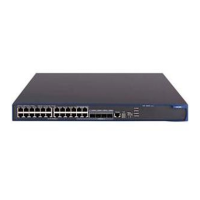4-3
Specifying the APP to be Used at Reboot
APP is the host software of the switch. If multiple APPs exist in the Flash memory, you can use the
command here to specify the one that will be used when the switch reboots.
Use the following command to specify the APP to be used at reboot:
To do… Use the command… Remarks
Specify the APP to be used at
reboot
boot boot-loader [ backup-attribute ]
{ file-url | device-name }
Required
Upgrading the Boot ROM
You can use the Boot ROM program saved in the Flash memory of the switch to upgrade the running
Boot ROM. With this command, a remote user can conveniently upgrade the Boot ROM by uploading
the Boot ROM to the switch through FTP and running this command. The Boot ROM can be used when
the switch restarts.
Use the following command to upgrade the Boot ROM:
To do… Use the command… Remarks
Upgrade the Boot ROM
boot bootrom { file-url |
device-name }
Required
Identifying and Diagnosing Pluggable Transceivers
Introduction to pluggable transceivers
At present, four types of pluggable transceivers are commonly used, and they can be divided into
optical transceivers and electrical transceivers based on transmission media as shown in
Table 4-1.
Table 4-1 Commonly used pluggable transceivers
Transceiver type Applied environment
Whether can be an
optical transceiver
Whether can be an
electrical transceiver
SFP (Small
Form-factor
Pluggable)
Generally used for
100M/1000M Ethernet
interfaces or POS
155M/622M/2.5G
interfaces
Yes Yes
GBIC (GigaBit
Interface Converter)
Generally used for
1000M Ethernet
interfaces
Yes Yes
XFP (10-Gigabit small
Form-factor
Pluggable)
Generally used for
10G Ethernet
interfaces
Yes No
XENPAK (10 Gigabit
EtherNet Transceiver
Package)
Generally used for
10G Ethernet
interfaces
Yes Yes

